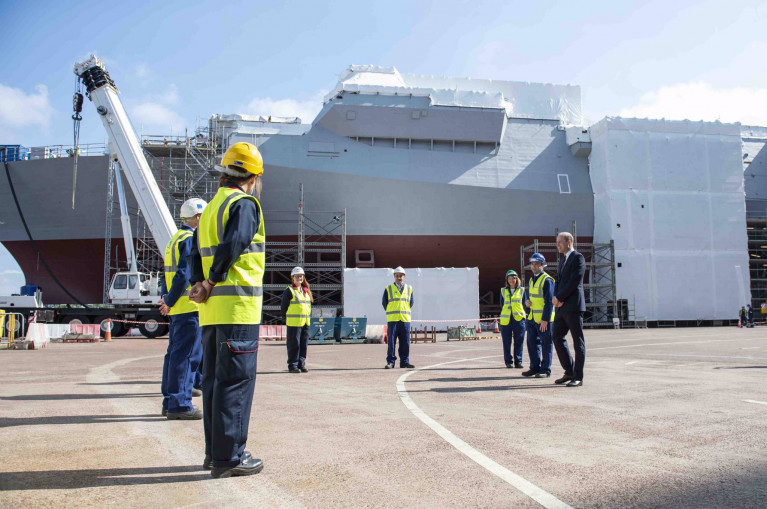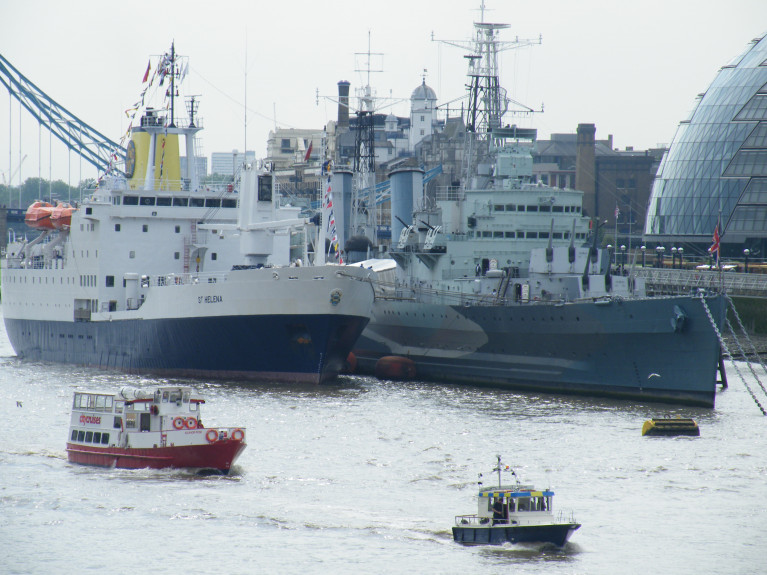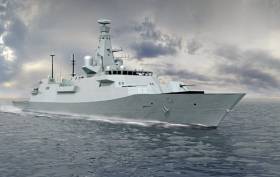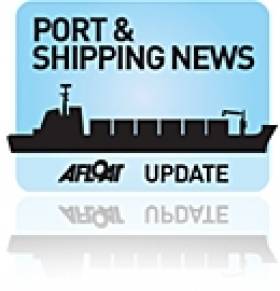Displaying items by tag: HMS Belfast
HMS Belfast: What's in a Name? As Steel Ceremony Takes Place for New 'City' Class Type 26 Frigate
At a shipyard in Scotland, Prince William cut the steel on HMS Belfast, a ship which will form part of a modern fleet serving the UK's Royal Navy for decades to come, reports BBC News.
Pushing down on a button in BAE Systems' Govan shipyard on Glasgow's River Clyde, he set to work lasers which moved across the first steel plate on the £1.2bn Type 26 warship.
The high-tech process is a long way from how its predecessor came into the world.
The keel laying - the starting point for construction at the time - for the first HMS Belfast (see flagship story), which has been moored on the River Thames for the past 50 years, took place in the Belfast shipyard Harland and Wolff in 1936.
The ship went on to be involved in some of the key battles of World War Two - including the Normandy landings and the Battle of North Cape.
It later also played a role in the Korean War.
With construction underway on the modern HMS Belfast, why do the two ships have the same name?
To read why and for much more here about the newbuild HMS Belfast, a name as Afloat previously reported, was first unveiled in 2017 by then UK Defence Secretary when visiting Harland and Wolff shipyard.
The Type 26 frigates, which will have the primary purpose of anti-submarine warfare, as the BBC also reported, however will see all eight of the City class built at the River Clyde shipyard.
In Times of Covid National Historic Ships UK Announce 'Virtual Flagship' Award to HMS Belfast
Across the Irish Sea the National Historic Ships UK which advises the Department of Culture, Media & Sport on grant giving organisations for ship conservation has in response to the impact of Covid-19 on the maritime heritage sector, made a significant change to its Flagship of the Year scheme.
The organisation which is the official voice for historic vessels in the UK, which usually reflects the cruising programme or visitor numbers of each craft, have instead welcomed applications for ‘virtual flagships’ in recognition of the fact that many historic vessels have had to cease operations, cancel or postpone events through circumstances beyond their control.
The Flagship Awards provide an opportunity to demonstrate and celebrate the value of our sector during these exceptionally challenging times. Our 2020 Flagships have been selected for their tenacity in continuing to raise their profile throughout the Covid-19 outbreak by online activities, social media, developing learning resources, offering virtual tours and other creative means. They will have our full online support over the coming months to help promote their vessels.
Hannah Cunliffe, Director of National Historic Ships UK, commented: “I am delighted that we are able to offer these Awards again as a means of supporting the sector at a time when it needs our help most. The creativity and resilience these vessels have shown in developing new online engagement packages to meet the current situation has been impressive and I look forward to working with them all in the months ahead.”
Flagships are expected to actively promote the role of National Historic Ships UK by sharing social media posts, publicising activities such as the annual Photo Competition, the Excellence in Maritime Heritage and Marsh Volunteer Awards. They will also be flying the flag as ambassadors for the UK’s maritime heritage sector.
The Flagships awards announced last month, receive grants of £500 and £250 respectively to be spent on the vessel or related digital activities and a special broad pennant to fly at the masthead once the ship is active again.
The National Flagship for 2020 is:
HMS Belfast for more infor click here
The Museum Ship which Afloat adds was launched on St. Patrick's Day 1938 at Harland & Wolff, Belfast is berthed in the Pool of London (see RMS St. Helena's historic only call to the UK capital) .
The former UK Royal Navy 'Southampton' class steam turbine powered battle-cruiser had a career spanning 25 years in active service. Among them saw HMS Belfast take part in WW2 and also during the Korean War in the 1950's.
A final visit to the ship's namesake city took place in the early 1960's.
Due to the determination of a group of men led by HMS Belfast's former captain, now Rear Admiral, Sir Morgan Morgan-Giles DSO OBE CM, they decided to save the ship and this led to the former warship brought to London.
In 1971 the HMS Belfast Trust was formed which saw the ship sail located to the Pool of London on the Thames as a floating museum which opened to the public that year on 21 October. Seven years later HMS Belfast became part of the Imperial War Museum.
A more recent highlight saw HMS Belfast selected to take part in the Avenue of Sail, for the Diamond Jubilee Pageant on 3 June 2012.
The 2020 Regional Flagships are:
Medway Queen (South East), Paddle Steamer
www.nationalhistoricships.org.uk/register/46/medway-queen.
Zebu (North West), Tall Ship
www.nationalhistoricships.org.uk/register/3474/zebu
ss Explorer (Scotland East), Research Vessel
www.nationalhistoricships.org.uk/register/26/ss-explorer
Spartan (Scotland West), Museum Ship
www.nationalhistoricships.org.uk/register/622/spartan
For more information on our winning entries visit www.nationalhistoricships.org.uk/page/our-flagships-2020
In addition to the National Register of Historic Vessels (NRHV), which lists over a thousand significant historic vessels: www.nationalhistoricships.org.uk/registers
There are currently over 1600 vessels on the NRHV.
The database includes details of designer, builder, dimensions, construction, propulsion, service history, current location and ownership, as well as images of many of the vessels.
If you would like to register your vessel, find out if your vessel meets our current criteria. Any data supplied when registering your vessel will be held by National Historic Ships UK in perpetuity for archival purposes.
For those of you who would like to analyse the NRHV in more detail please go here for download.
To search for a ship on the register, click here.
UK's Royal Navy Name New Warship HMS Belfast
#NewHMSbelfast - One of the newest warships for the Royal Navy is to be called HMS Belfast writes The Irish News.
Defence Secretary Sir Michael Fallon made the announcement as his visited Harland and Wolff shipyard in the city, where the Navy's last HMS Belfast was built prior to World War Two.
The ship will be one of eight new Type 26 frigates joining the Navy's fleet. It will be used to protect the UK's nuclear submarines and aircraft carriers.
One of the "City Class" frigates has already been christened HMS Glasgow. They are due to enter service in the mid 2020s.
"I'm hugely proud that the second name announced of our eight cutting-edge new Type 26 frigates will be HMS Belfast," said Sir Michael.
For further comments made by the Defence Secretary on the frigate newbuild click here.
Birthday Bash as HMS Belfast Celebrates 75th Anniversary
#HMSBelfast – The Thames floating landmark, HMS Belfast celebrates its 75th anniversary, coinciding with this weekend's St. Patrick festivities held on both sides of the Irish Sea, writes Jehan Ashmore.
The Town-Class cruiser was launched on St. Patrick's Day 1938 from Harland & Wolff, Belfast. She is one of the last surviving WW2 warships remaining in UK waters. She was commissioned into the Royal Navy the following year and placed under the command of Captain G.A. Scott DSO.
During her career, HMS Belfast opened fire in support of Allied troops during the D-Day landing, was on escort duty during Artic convoys of merchant ships in addition to involvement in the Korean War.
To commemorate the historical significance of HMS Belfast, which has been moored on the Thames since 1971 as a major tourist attraction, a series of special events are to be held this weekend.
Her Belfast-based counterpart, the C-Class light cruiser HMS Caroline, which served in World War I having been built in 1914 at Cammell Laird, Birkenhead, lies on the Lagan.
As previously reported, the fate of the former Battle of Jutland survivor was secured following last year's decision to protect the vessel from falling into disrepair with a £1m restoration grant.
On completion of the work on the veteran vessel now in her 99th year, she is to become a major tourist attraction likewise of HMS Belfast.
Harland & Wolff Secure Dry-Docking Contract of Canadian FPSO
#PORTS & SHIPPING – Harland & Wolff Heavy Industries Ltd (H&W) have secured a contract to dry dock and service the Searose (2004/139,950dwt) a Canadian east coast based floating production storage and offloading (FPSO) vessel later this year.
The 272 metres long by 46 metre beamed FPSO is operated by Husky Oil and is based at the White Rose oilfield, 350km off the Newfoundland coast.
Searose will be dry-docked at H&W's Belfast Repair Dock and also use the Repair Quay during May and June. The work at the Queen's Island facility will be led by an integrated project team made up of owner and H&W personnel along with key contractors and vendors.
"H&W, along with our key contractors, are pleased to have secured the SeaRose FPSO project and to demonstrate the capabilities of the UK Oil & Gas supply chain," said H&W Project Manager James Lappin.
"This is an important opportunity, not only for H&W but for Northern Ireland, to extend a welcome to our Canadian visitors and demonstrate our world class facilities."
"We are proud that they have put their trust in us," H&W Chief Executive Officer Robert J Cooper said. "All levels of H&W are committed to ensuring this important project is completed safely and successfully."
H&W was founded over 150 years ago and has built some of the world's most famous ships, including three from the White Star Line: the Olympic, Titanic, and the Britannic, P&O's Canberra and the RN World War II battle-cruiser HMS Belfast, where she remains at moorings on the Thames.
Tripartite Naval Visitors for Dublin Port
Naval vessels from France, Canada and Belgium are due to make calls to Dublin Port over the weekend, writes Jehan Ashmore.
The first visitor to dock tomorrow will be the Latouche-Tréville (D646) a F70 type anti-submarine frigate of the French Marine Nationale. She is one of seven F70 ASM class anti-submarine frigates and is capable of carrying two 2 Lynx helicopters. In June 2010 the frigate visited London where the 1984 built 3,550 tonnes vessel moored alongside the WW II cruiser, HMS Belfast.
Also due to arrive tomorrow is the Canadian Navy's HMCS St. John's which too is to berth at Ocean Pier. HMCS St. John's (340) is the eleventh 'Halifax' class frigate, measuring some 4,770 tonnes. The multi-role patrol frigate was commissioned in 1996 in St. John's, Newfoundland and is designed to perform three distinct functions: anti-submarine warfare, anti-air warfare and anti-surface warfare.
On Sunday the third international naval visitor to Dublin Port will be the Belgium Navy's Léopold I (F930). This frigate is based in the Quartier Naval Base in Zeebrugge and in 1997 she was commissioned into service in a ceremony by Belgium's Queen Fabiola.
The 2,800 tonnes frigate is capable of taking two helicopters and the vessel can cruise at 21 knots using two diesel engines or is capable of reaching a top speed of 30 knots based from gas turbine power-plants. Léopold I has participated in NATO's Response Force (NRF). For a detailed visual discription of equipment click this link here


































































